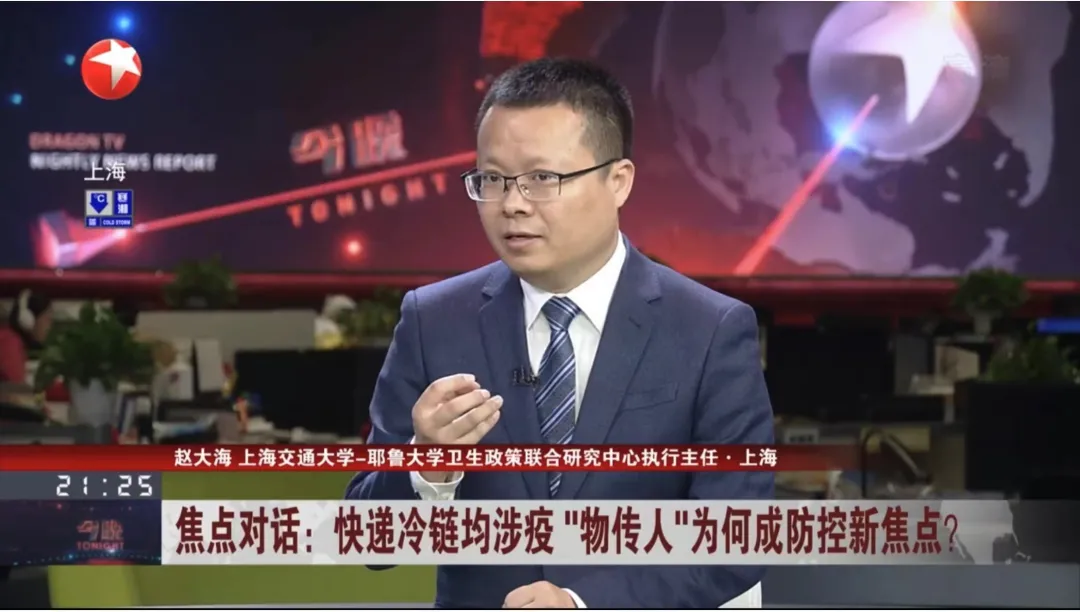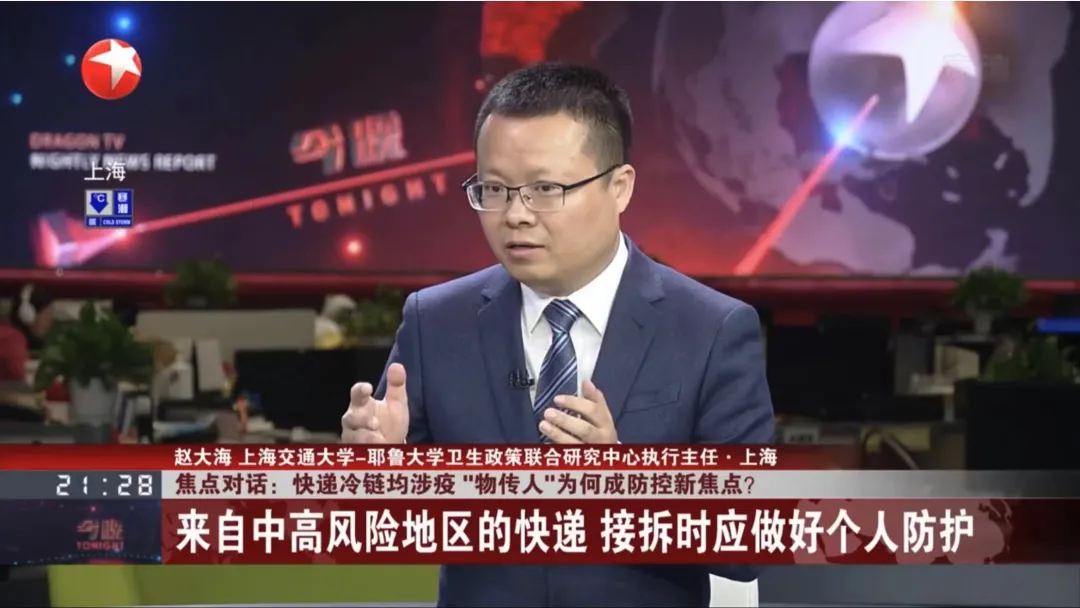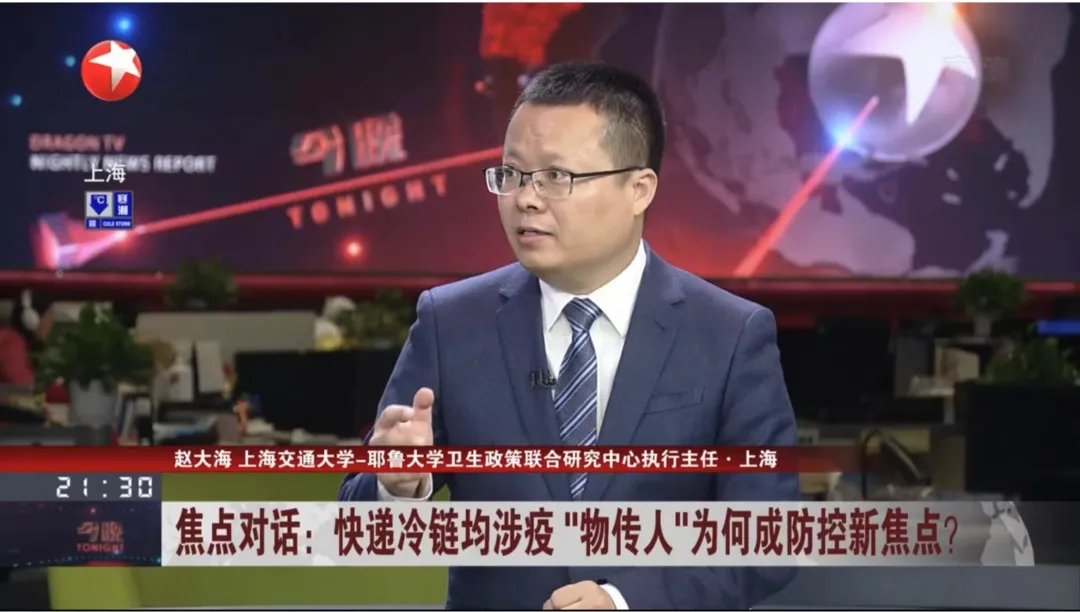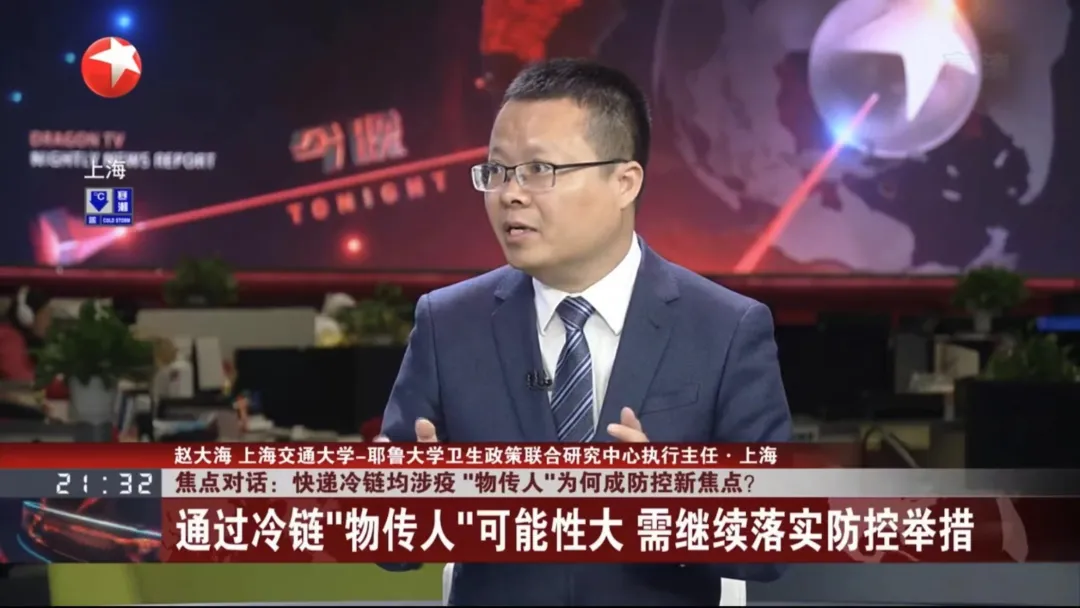上海交大赵大海做客东方卫视演播室:通过“快递”传播新冠病毒的可能性比较小

上海交通大学国际与公共事务学院教授、博士生导师,上海交通大学-耶鲁大学卫生政策联合研究中心执行主任赵大海,自新冠肺炎疫情暴发以来,对于新冠疫情暴发、防控以及卫生政策第45次接受上海电视台专访,也是第109次接受央视、上视专访。2021年11月8日,赵大海做客东方卫视演播室,在《今晚》节目,就最近有关快递和冷链“物传人”关联的新冠疫情防控进行了解释和评论,现将访谈内容摘录如下。

主持人:刚才那个小片我们看到,三个确诊新冠病例,是从事商贸活动,因此就引发了大家对快递是否安全的这样一种担心。比如说,有些地方对快递进行简易的排查。所以问题来了,这个病毒附着在快递的包装,甚至包括里面的一些商品上面的话,如果真的附着上的话,它的存活期大概有多长,另外通过这样的一种方式感染新冠肺炎的可能性有多大?
赵大海:到目前为止,在我们中国大陆,还没有发现一例直接由快递而引起的相关新冠病例。无论是中国还是世界其他国家,通过对于快递表面的新冠病毒检测,发现通过快递传染新冠病毒的可能性非常小,病毒存活时间也是非常短。美国CDC的数据显示,可存活大约几个小时,中国的实验室检测数据显示可以存活大概一天左右。

主持人:那么我们都知道,刚才那个小片讲,马上就“双11”,进入到快递、网购的高峰期了,那么现在可以看到网购的很多商品的来源,可能是一些高风险地区或中高风险地区。那么有些来源实在是搞不清楚它到底来自什么地方,因此我们在取件的过程当中,应该做好哪些防护的措施?另外我们可以看到,有些地方对涉疫的一些快递的人员还进行隔离。那么这些做法您的看法是什么?
赵大海:我先回答第二个问题,就说对于涉疫快递以及相关的人员进行相应隔离,反映出我们各地各级政府对于疫情防控的高度重视,我们生怕万一出现新冠病毒,特别是在冬季到来的时候,可能会引起潜在的、意想不到的新冠的局部暴发,这也反映出我们整个工作做的非常扎实。对于您刚才提到的第一个问题,按照过去近两年的疫情防控的经验来来看,我们已有了一个比较成熟的流程,也就是说我们首先戴好口罩、一次性手套,在拆除外包装之后,及时地把外包装送到垃圾处理的地方;然后科学洗手。整个一个流程下来,我们还是能够非常好地防控住新冠病毒。

主持人:我们根据大连的首站定点冷库的有关规定,我们可以看到,接触进口冷链食品加工的这些工作人员要实行集中居住。那么流调的信息却显示,在被发现之前,这些多名确诊的冷库的员工其实在外面有居住,另外也有活动的这样一个经历。所以这暴露了什么?因为跟冷链接触,所发生的确诊的事件以前也有,而且还不止在一个地方。所以这提醒了我们什么?这是一个问题,另外对当前的疫情,又敲响了怎样的警钟?因为我们目前的形势还算是比较严峻,多点散发。
赵大海:暴露出来的问题,应该讲是非常清晰的,就是说我们已经有了比较完备的、而且是既定的疫情管控政策,包括对于冷链冷库的相关工作人员的管控政策。但是随着防控时间的拉长,难免存在的一些地方在疫情管控政策的执行方面出现了一些疏漏。相应的警示,也就是我们各地的相关部门,一定要严格地执行我们原先既定的各项疫情管控的政策,防范类似事件的再次发生。
主持人:是的,其实政策都有,规矩也有,只是把这个政策和规矩做得更严一点很重要。另外冬天已经到了,所以现在我们看到,德尔塔病毒其实传播力度特别强,所以这给疫情带来怎样的挑战?这是季节性的因素。这第二个问题,这次是物传人。同时,我们要避免人传人,所以根据您专业的意见来看,我们进一步加强防范的话,重点要抓住几个方面?
赵大海:首先刚才您提到的这个挑战,那随着冬季的到来,我们整个新冠疫情防控的任务一定是比前段时间更要严峻。而且,我们各级医疗机构还要尽快掌握,对于冬季传统呼吸道传染病跟新冠病毒的快速的鉴别的能力,以及与之相关的一些压力和挑战的工作。另外,于刚才您提到的物传人和人传人之间,到目前为止我们非常明确的有依据的物传人,还是冷链途径的物传人。因此,我们要以冷链的物传人为主,同时,还是要把最重点放到人传人的这个方面,而对于其他的低风险地区之间的物品的流转方面,我们现在还不需要提升对他们的疫情管控措施。
供稿:国务学院
日期:2021年11月9日
Dahai ZHAO’s Exclusive Interview with ShanghaiTV: Covid is less likely to spread by courier delivery
Dahai Zhao, a doctoral supervisor at the School of International and Public Affairs of Shanghai Jiao Tong University and Executive Director of Shanghai Jiao Tong University-Yale University Joint Research Center for Health Policy, has been interviewed by ShanghaiTV for the 45st time (the 109st time by CGTN / ShanghaiTV) since the COVID-19 pandemic. On November 8, 2021, Zhao commented on COVID-19 transmission on delivery and cold-chain products on “Tonight” of Shanghai TV.
Anchor: We saw that the three confirmed COVID-19 cases were engaged in commercial activities, which raised concerns about the safety of delivery services. For example, some places conduct simple screening of deliveries. So the question is, if this virus is attached to the package of delivery, and even some of the goods inside, how long is it likely to live, and how likely is it to infect COVID virus in this way?
ZHAO: So far, there has not been a single case of COVID-19 directly caused by courier delivery in mainland China. According to novel coronavirus tests on the surface of the courier in China and other countries in the world, the possibility of transmission of COVID through the courier is very small and the survival time of the virus is very short. According to the CDC in the United States, it can survive for several hours, and Chinese laboratory tests show it can survive for about a day.
Anchor: We will soon enter the peak of “11.11" courier delivery. So now we can see that many products purchased online may come from high-risk or medium-high-risk areas. Some of the sources are really unclear where it comes from. Therefore, in the process of taking courier, what protective measures should we take? In addition, we can see that in some places, some courier delivery personnel involved in the epidemic have been quarantined. So what do you think about these?
ZHAO: I'll take the second question first. The quarantine of courier delivery and related personnel reflects the great importance that Chinese governments at all levels attach to epidemic prevention and control. Especially as winter approaches in case there is a potential and unexpected local outbreak of COVID. It also reflects that our work is very strong. As for your first question, based on the epidemic prevention and control experience in the past two years, we have developed a relatively mature process management. That is to say, we first put on masks, disposable gloves, after removing the outer packaging, send the outer packaging to the garbage disposal place in time. Then wash the hands carefully. Throughout the process, we can still maintain a very good containment of the Novel Coronavirus.
Anchor: According to Dalian's first station fixed-point cold storage, we can see that these staff in contact with cold chain food processing should be concentrated in residence. But anecdotal information suggests that many of the employees who were diagnosed had been living and doing things outside the fixed points before they were discovered. What does that tell us? There have been confirmed cases of exposure to the cold chain and they were found more than one places before. What does this remind?
ZHAO: We already have a relatively complete and established epidemic control policy, including the control policy for cold-chain cold storage staff. However, with the extension of the prevention and control, it is inevitable that there are some omissions in the implementation of epidemic control policies in some places. It warns relevant departments of local governments to strictly implement our original epidemic control policies and prevent similar incidents from happening again.
Anchor: In addition, winter has arrived, and the spread of The Delta virus is particularly strong. What challenges does this bring to the epidemic? It's seasonal. The second question, this time is about goods-to-human transmission. What should we focus on the further preparedness?
ZHAO: With the arrival of winter, the task of COVID-19 prevention and control is bound to be more serious than before. In addition, our hospitals need to master as soon as possible the skills to distinguish traditional respiratory infections in winter from novel coronavirus infections, as well as the pressure and challenges associated with them. In addition, so far we have very clear evidence of goods-to-human transmission, only on cold-chain transmission. Therefore, we should deem cold chain as the main way of goods-to-human transmission. At the same time, we still need to focus on the aspect of human-to-human transmission. In terms of the movement of goods between other low-risk areas, we do not need to increase containment measures for them yet.
Contributor: SIPA, SJTU
Date: November 9, 2021

